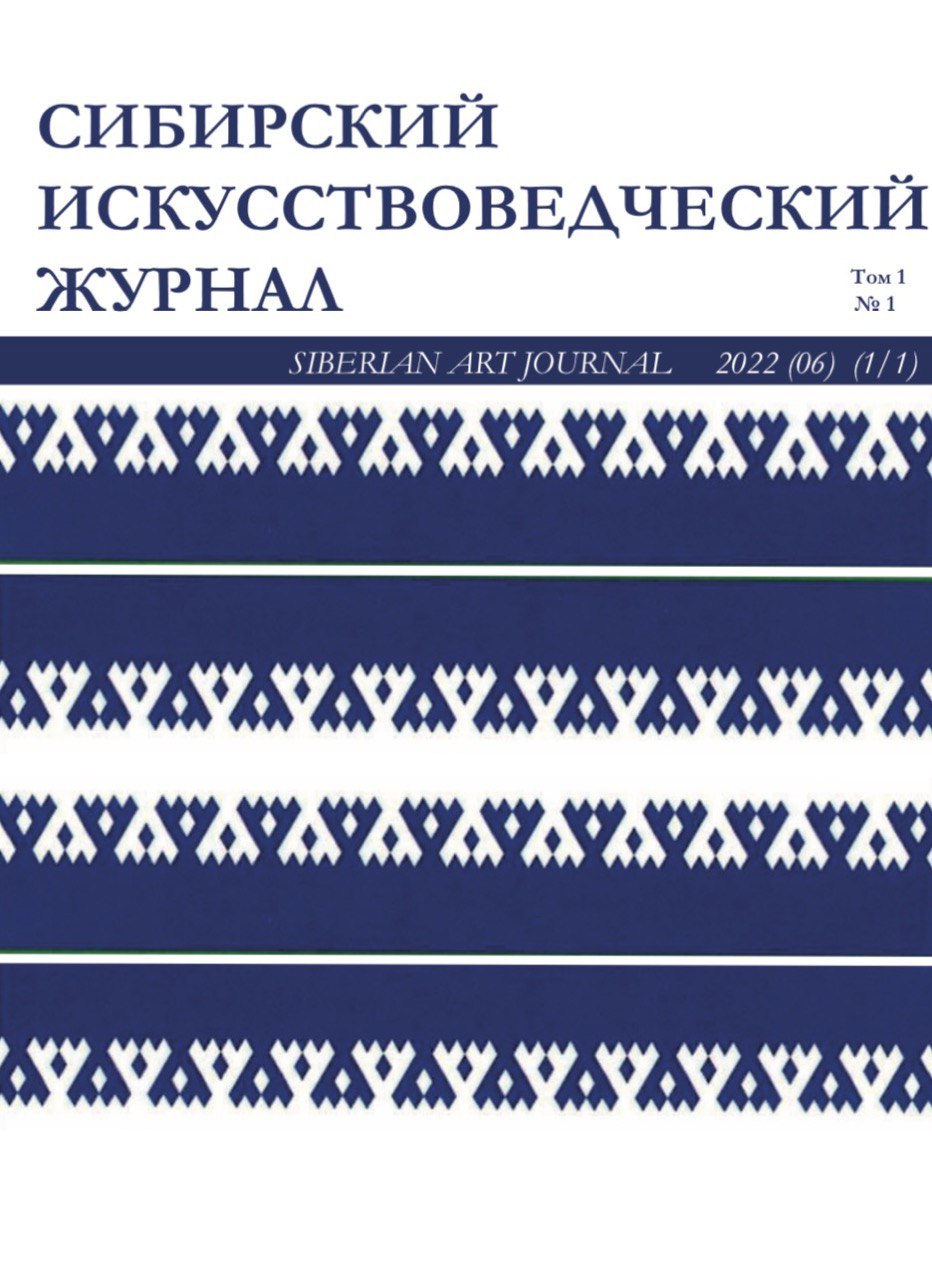This article explores the image of the ladies' toilet in the fine arts of the mid-17th - early 20th centuries. The premise of the study is the growing interest in studying the issue of the evolution of women's fashion and the transformation of the traditions of the ladies' toilet over several centuries. The purpose of the study is to trace the transformation of the process of collecting and putting in order the appearance of ladies in paintings from the mid-17th to early 20th centuries. The study includes the study of socio-political, technological and stylistic factors and their influence on the ritual of ladies' gatherings, as well as their reflection on paintings. The main research method was a factorial and comparative analysis of paintings depicting the ritual of the ladies' toilet, such as «The Lady's Toilet» by Gerard Terborch, «The Morning Toilet» and «The Lady at the Toilet» by Jan Steen, «The Morning Toilet» by J. B. S. Chardin, « A Lady's Toilet by François Boucher, Woman at the Dressing Table by Gustave Caillebotte, Nana by Edouard Manet, At the Dressing Table. Self-Portrait by Zinaida Serebryakova and Girl Combing Her Hair by William McGregor Paxton. Based on the patterns identified during the analysis, a comparative analysis of the traditions of the ladies' toilet of the 17th - 18th and 19th - 20th centuries was carried out. At the end of the study, the key features of each historical period were identified, the influence of sociocultural and political factors on fashion and it was possible to trace the transformation of the traditions of ladies' dressing, picturesquely reflected in the elements of the surrounding space, the decoration of the dressing table, sanitary and hygienic means, fashion and medicine and their influence on the image women.
ladies' toilet, female image, hygiene, fashion
1. Bogdanov, I. (2007). A brief history of the toilet. Moscow: New Literary Review. 192.
2. Borodina, S., & Vlasova, E. (2017). The mirror – a symbol of vanity, luxury, and pride. World of Arts: Bulletin of the International Institute of Antiquities, 2(18), 86–93.
3. Vlasova, E. (2013). Fireplace “Canon”: Decorative and functional accessories for fireplaces at the BSII ASG. World of Arts: Bulletin of the International Institute of Antiquities, 4(04), 117–123.
4. Vlasova, E. (2017). Collection of sanitary and hygienic items from BSII – from luxury to civilization. World of Arts: Bulletin of the International Institute of Antiquities, 1(17), 146–149.
5. Volobueva, M. M. (2022). «The Latest Fashion». Fashion trends of the 18th-19th centuries. On the Way to a Civil Society, 3(47), 37–41.
6. Volobueva, M. M. (2022). Accessories as finishing touches to a fashionable image. On the Way to a Civil Society, 4(48), 32–38.
7. Gostinshchikova, I. A. (2016). Ladies’ things. Kirillo-Belozersky Historical-Architectural and Art Museum-Reserve, 1–20.
8. Gusarova, K. (2020). “Made-up” paintings and “painting” on the face: Makeup in the context of European art culture of the modern era. Art History, 3, 40–55.
9. Yelatomtseva, T. (2010). Holland in the mid-17th century: How they walked and what they wore. Reenactor, 1–24.
10. Zharinov, E. (2021). Fallen Enlightenment: The Shadow of an Era. Moscow: AST. 512.
11. Kalshchikova, A. A. (2023). Semiotics of French women's fashion: From the Middle Ages to modern times. Bulletin of Moscow State Linguistic University. Humanities, 13(881), 37–42.
12. Kanchayeva, F. R. (2019). The connection between time and the emotional-atmospheric component of a painting using the example of genre paintings by artists of different eras. Art and Cultural Dialogue, 414–418.
13. Karnaukhov, D. V., & Polinovskaya, E. A. (2021). The concept of «Modern Era» in Russian and foreign academic traditions. Siberian Teacher, 5(138), 35–39.
14. Knyazeva, V. P. (1979). Zinaida Evgenyevna Serebriakova. Moscow: Fine Art. 256.
15. Koroleva, A. Y. (2022). Between «degeneration» and «renaissance»: Female images in the painting of New Objectivity. Current Issues in Theory and History of Art, 12, 450–459.
16. Lavrentyeva, M. A. (2018). Historical aspects of the creation and development of the perfume and cosmetics industry. Electronic Multidisciplinary Journal «Scientific Works of KubSTU», 11, 185–194.
17. Magomedov, N. A. (2015). Derbent in the structure of Russia's eastern trade at the turn of the 17th-first quarter of the 18th century. History, Archaeology and Ethnography of the Caucasus, 1(41), 21-32.
18. Melaya, T. G., & Kozlova, T. V. (2016). The influence of scientific and technological progress on 20th-century fashion. Innovation and Investment, 6, 94–100.
19. Molotnikova, D. (2023). Royal amusements: Attribution of a seating furniture set from the Louis XVI era. World of Arts: Bulletin of the International Institute of Antiquities, 2(42), 72–87.
20. Pavlova, Y. B. (2010). Fashion for flower-decorated carpets in 17th-century Holland. Proceedings of St. Petersburg State Institute of Culture, 189, 93–97.
21. Punanova, N. S. (2020). Folk trends in Russian fashion of the early 20th century. Traditional Applied Arts and Education, 4(35), 174–182.
22. Sova, A. E. (2021). «Morning toilet» as a section of genre painting and the specifics of working with students of different ages in children's art schools on the thematic composition «Morning of my home.» Bachelor's thesis in Pedagogical Education (44.03.01).
23. Stafievskaya, M. V., & Minina, E. A. (2017). Analysis of people's everyday life and lifestyle through painting: Historical aspect. Bulletin of Mari State University. Series: Historical Sciences. Legal Sciences, 2(10), 39–44.
24. Torebayev, B. P. (2017). Hosiery: History of origin and development, characteristics, artistic design. In Quality Management: Search and Solutions: Materials of the III International Scientific-Practical Conference (Vol. 2, pp. 526–528). Kuala Lumpur, Malaysia.
25. Chernysheva, I. V., Cheremushnikova, I. K., & Petrova, I. A. (2017). 19th-century historical sources on women's health and fashion. Izvestia of Volgograd State Pedagogical University, 6(119), 152–156.
26. Chernysheva, M. A. (2016). Charles Baudelaire on makeup: Poetics of anti-ruin. Decorative Art and Object-Spatial Environment. Bulletin, 2, 290–296.
27. Thornton, P. (1978). Seventeenth-century interior decoration in England, France and Holland. New Haven and London: Yale University Press. 427.





